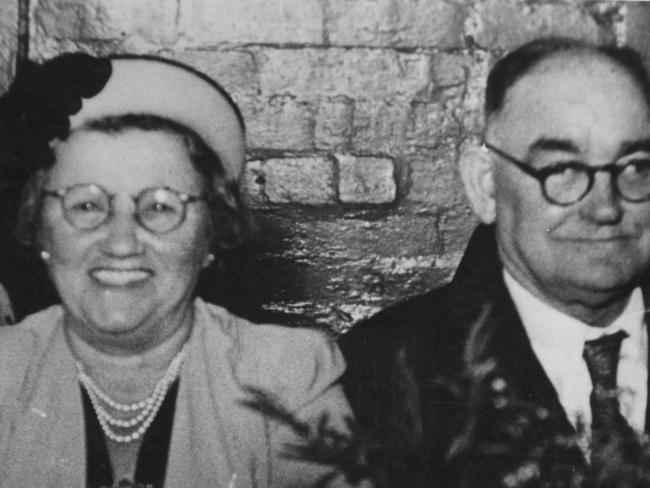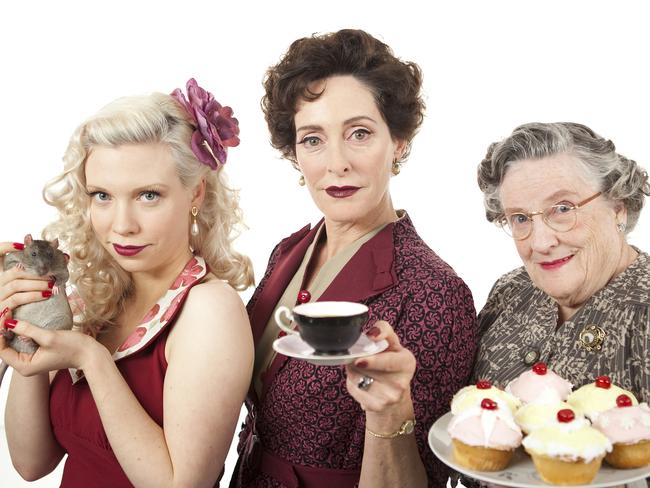GRANNY Grills’ visits to family bearing home-baked goodies and tea were always welcome. But no one could believe the short, dumpy Sydney woman with thick-rimmed glasses was actually a suspected serial killer poisoning those she simply wasn’t fond of.
Caroline Grills’ infamous family visits later earned her the nickname “Aunty Thally” from fellow Long Bay Jail inmates because of the type of poison she used on her victims: thallium, a rat killer.
The sensational poisoning case was one of many that scandalised post-war Sydney and would inspire an ABC program, Recipe For Murder, about Grills and two other women accused of murder and attempted murder by thallium — also called “inheritance powder” and “the poisoner’s poison” — in the early 1950s.
Sydney in the 1950s was far from a white-picket-fence paradise, rather the early post-World War II period was a time of social upheaval. Returning soldiers often suffered untreated war trauma, housing conditions were poor and often overcrowded, and in the inner-city, rats sometimes nibbled the faces and feet of sleeping children.

Thallium sulphate, sold at corner shops and chemists, killed rats that ate the bait and rats that ate the corpse. Odourless and tasteless, thallium became the murder and suicide poison of choice. One gram in cakes or mixed in tea and hot-chocolate drinks could kill within two weeks.
In 1953, Grills, a 63-year-old Gladesville grandmother, was charged in NSW with attempted murder over the poisonings of her Redfern sister-in-law Eveline Lundberg, and Lundberg’s daughter Christine Downey.

Both victims had exhibited symptoms common in thallium poisonings, including hair loss, increasing blindness and loss of speech.
The poisonings came to light when a family member spied Grills reaching into her dress pocket and dropping something into the cup of tea she was carrying. He switched cups and took a sample of the tea to police, who tested it and found it contained thallium.
Investigators then examined the deaths of other members of Grills’s family, including her stepmother Christina Mickelson in November 1947.
In January 1948 a relation of her husband, Angelina Thomas, became another suspected victim.


Her husband’s brother-in-law John Lundberg died in late 1948, and one of her stepmother’s friends died the following year. Throughout 1951 and 1942 various family members became ill, including Mrs Lundberg, but all survived.
One of those who had been sick, John Downey, read a story in a newspaper in October of 1952 about poisonings, raising his suspicions about “Auntie Carrie”.
Then, when he saw her putting something in a tea cup he went to police.
Investigators exhumed several bodies and found traces of thallium in two, while others had been cremated and could not be tested for poison.


At a coroner’s inquest, witnesses recalled Grills bringing them drinks, and how eager she was to help with preparing food and tea.
Mrs Lundberg described how her hair had started to fall out and she had slowly gone blind.
The coroner found Grills responsible for several deaths.
She was charged with the murders of Mary Anne Mickelson, 60, Christina Louisa Adelaide Mickelson, 87, and Angelina Thomas, 84.
But in the end those cases were dropped, and Grills was convicted only of the attempted murder of Mrs Lundberg, in October 1953.
At her trial in Sydney’s Central Criminal Court, Grills maintained her innocence, claiming police pressured her relations to convict her.
But the prosecution alleged she was “a killer who poisoned for sport, for fun, for the kicks she got out of it, for the hell of it, for the thrill that she and she alone in the world knew the cause of the victims’ suffering”.

The jury deliberated for just 12 minutes. Grills was sentenced to death. This was later commuted to life in prison.
On hearing the verdict Grills declared: “I helped to live, not to kill.”
Soon afterwards thallium was banned from sale.
Grills was admitted to the State Reformatory for Women where she spent the next six years. Rushed to Prince Henry Hospital, Grills died of peritonitis on 6 October 1960.

Add your comment to this story
To join the conversation, please log in. Don't have an account? Register
Join the conversation, you are commenting as Logout
Person with serious injuries after NW single-car crash
Police have closed a northwest Tas road where a single vehicle has crashed, leaving one person with serious injuries. The latest.
‘Red flags’ exposed on hundreds of Working With Children Checks
An online screening company used by high-profile sporting bodies including the AFL has found more than 500 people with suspended or no longer valid permits, highlighting serious flaws in the child safety system.